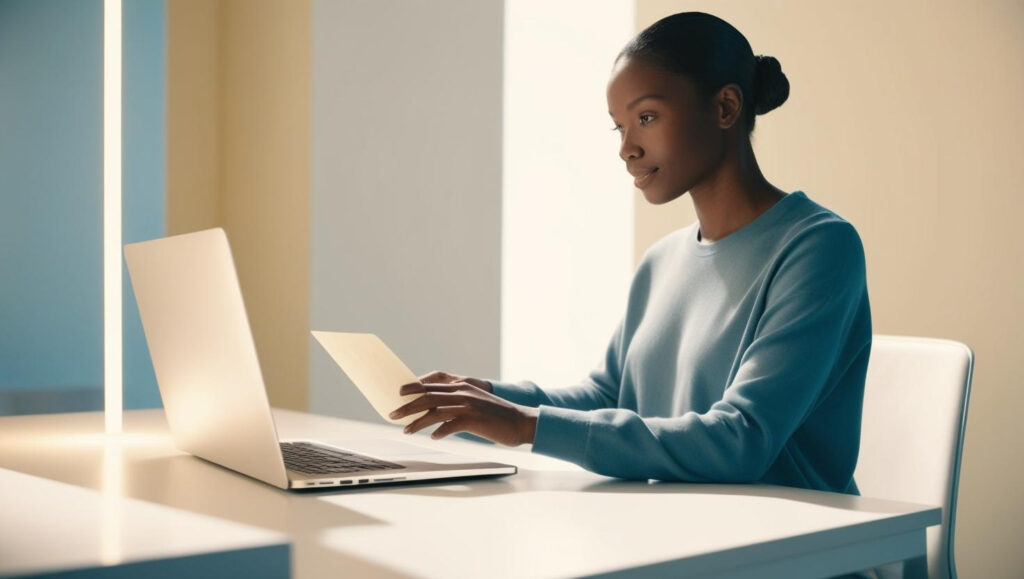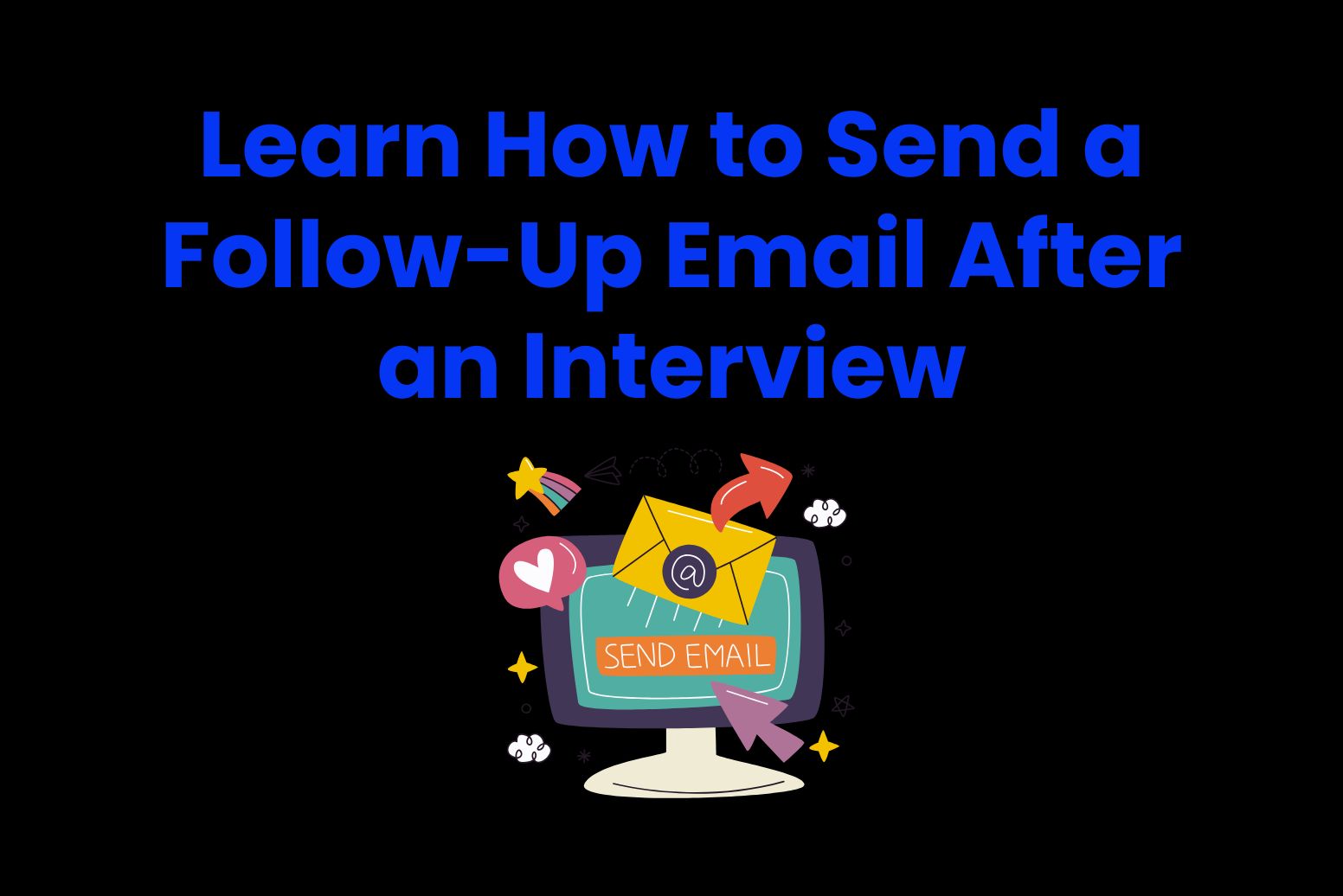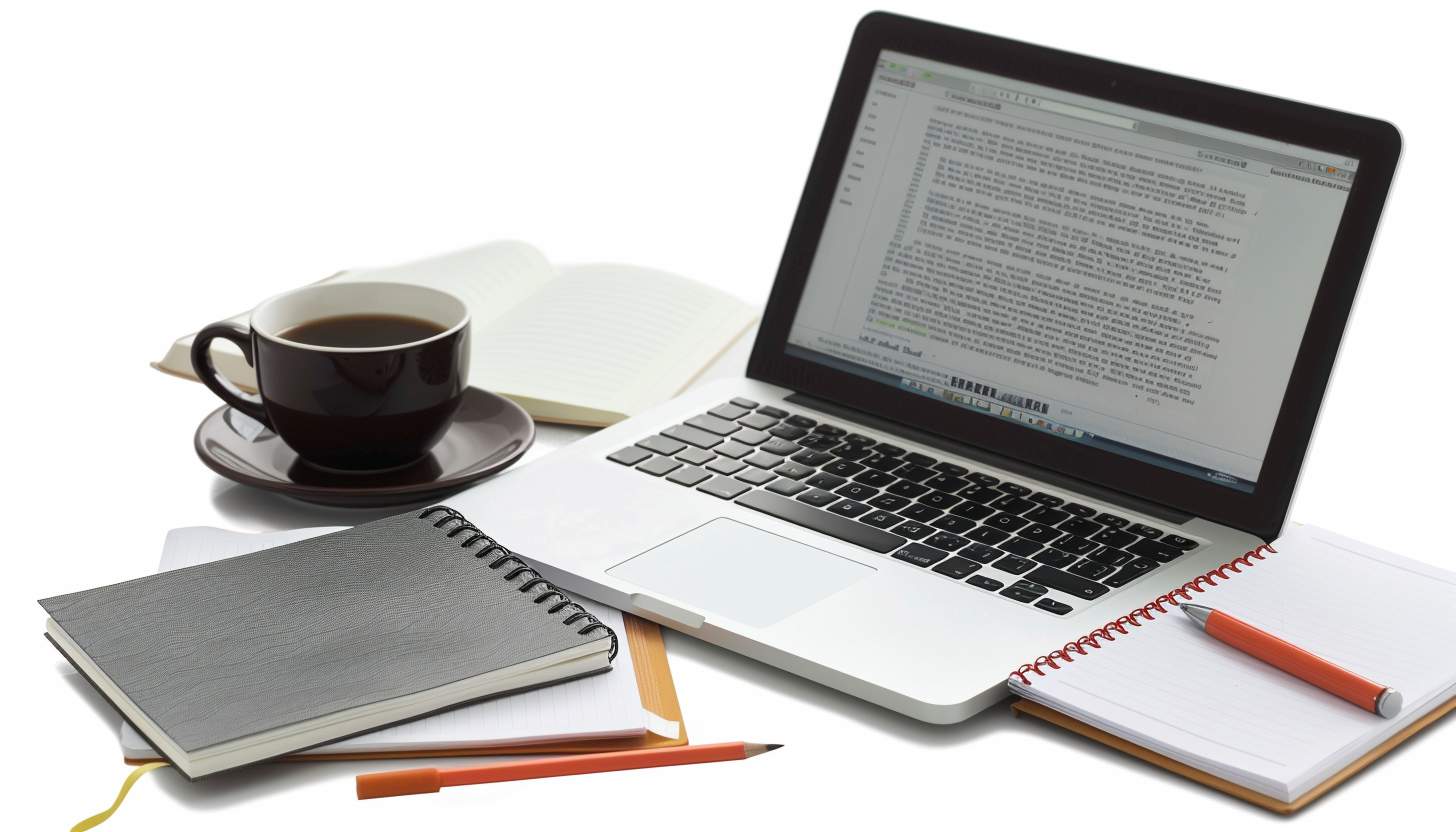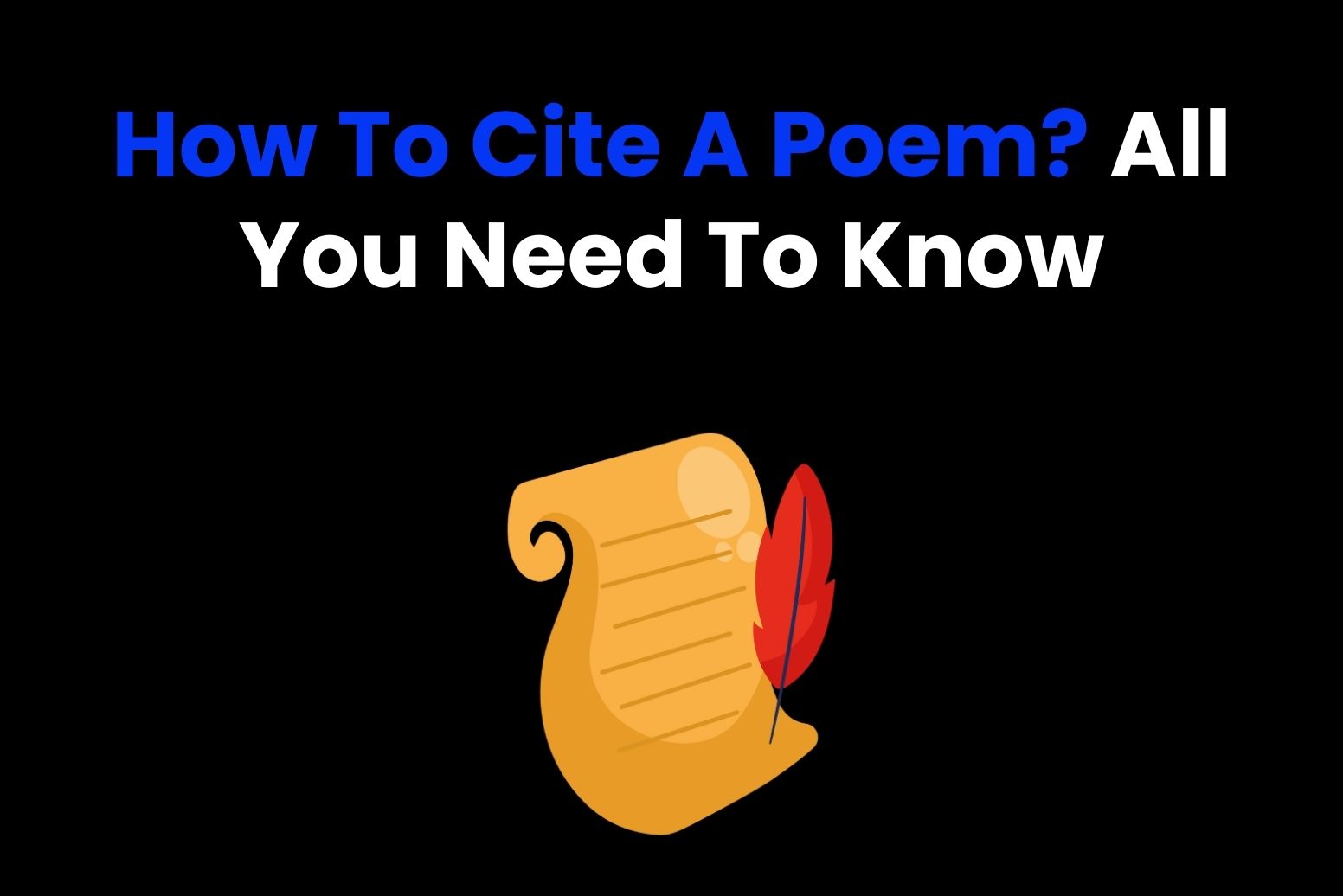Discovering how to send a follow-up email after an interview will stand you in good stead as you wait to hear about the job.

If you’re between work, this is undoubtedly a nerve-wracking time. Therefore, checking in with a follow-up email can help you potentially get some answers. A carefully written email may also help your chances of hearing good news in the near future.

So, in this article, we explain how to send a follow-up email after an interview. We explain what should and should not be included in the email and show you how to use AI to your advantage.
What is the purpose of a follow-up email?

A follow-up email is a way of touching base after a job interview. It’s a gentle and polite reminder to the hiring manager that you’re keen to hear back from them and are still interested in the job.
You can also use the follow-up email to elaborate on some points made in the interview and to thank the hiring manager for their time. It’s so important to be polite, courteous, and professional in the email.
You should not use the follow-up email to beg for a job or to put the hiring team under pressure. After all, a poorly executed follow-up email after an interview can actually harm your chances of getting the job.
Therefore, learning how to send a follow-up email after an interview and understanding the etiquette will help you make a good impression.
Do hiring managers appreciate post-interview outreach?
Some people might think that sending an email to a hiring manager after a job is a bad idea. After all, it may seem like you’re too eager or are trying to put pressure on the person to make a decision.
But research shows that potential employers actually appreciate it when candidates get in touch after the interview. Of those contacted for the study, 87% said they appreciated receiving a follow-up email. 81% said they appreciated a phone call.
However, most crucially, over 90% of the hiring managers said that they appreciated being thanked for their time. So, if you’re on the fence about sending a follow-up email, do it. The vast majority of hiring managers will be grateful, and provided you get the tone and content right; it can help your chances.
Etiquette: How to send a follow-up email after an interview
So, we’ve established that sending a follow-up email after a job interview is a positive step. But how do you go about it? Well, as with everything, you must be aware of follow-up email etiquette. Here are some things to bear in mind before writing your email:
Time it right
The ideal time to follow up is within 24 hours. We advise you not to leave it any longer than this. After all, the interviewing team will probably be seeing numerous candidates for the position, so you need to touch base as soon as possible after your interview.
Also, if your interview is on a Friday afternoon, send your follow-up email before the weekend. You can do it on the train or bus home to ensure you touch base before the hiring manager relaxes over the weekend.
Send it to the right person
Though it might seem apparent, following up with the right person is key. Check that you have the right email address and phone number for the person who conducted the interview.
If you don’t, you can ask for the person’s contact information at the end of the interview. Alternatively, send an email to your contact in the company and ask them to send you the correct details.
Be positive and polite
No matter how you think the interview went, you must be positive and polite in the follow-up email. Now is not the time to take a shot at the interviewer or to be negative about something that was said in the interview.
Anything other than a positive and polite tone will significantly harm your employment chances. Even if you think the interview went badly, you should be polite. After all, you might not get this job, but there may be another opening sometime in the future that’s well-suited to your skills.
How to send a follow-up email after an interview: The ideal structure
Learning how to send up a follow-up email after an interview will stand you in good stead as you await the outcome. The days between the interview and hearing back from the hiring manager are tense and anxiety inducing, so sending an email can help to bridge the gap.
If you’re unsure what to include in a follow-up email, check out the ideal structure below:
Subject line
The subject line is an essential part of the email, though it’s not in the main body of the text. Being concise is key, with research showing that subject lines with 50 characters or less result in 75% higher click-through rates than those that are longer.
So, with that in mind, here are some ideal subject lines to include when following up on your recent interview:
- [Your Name] Interview follow-up
- Interview [Date] – Thank you for your time
- [Interviewer Name] – Interview feedback?
- Following up – Thank you for the interview
Above all else, keep the subject line clear, concise, and to the point. You don’t need to go into great detail. It should clearly state the purpose of the email and encourage the recipient to open it.
Salutation
The way you greet the interviewer in the follow-up email is extremely important. In fact, it’s just as crucial as how you greeted them when you met them in real life.
You perhaps went with a firm handshake and eye contact in your face-to-face meeting. Such an approach isn’t possible in an email, which is why your choice of salutation is key.
Avoid overfamiliarity and choose a formal, polite, and appropriate greeting. For instance, the following salutations can work well in a follow-up email:
- Dear [first name]
- Good morning/afternoon [first name]
Don’t use “hello” or “hi” as a salutation, as they’re not formal enough. You can typically use the interviewer’s first name, as we assume that you’re now on first-name terms following the interview.
Expression of thanks
Though the expression of thanks often comes at the end of most other emails, it should be the first line of your follow-up email. Why? Because it should appear to be the main reason you’re reaching out.
After all, everyone likes to be thanked for their time. So, starting by showing your gratitude is a brilliant way to get the email off to a positive start.
Don’t go overboard here, as you don’t want to come across as insincere. Rather, a simple statement of your gratitude will be more than sufficient. For example:
- Thank you very much for taking the time to meet me this afternoon for an interview.
- I really appreciate the opportunity to meet you and [other interviewers] to discuss the available role with [company].
- I’m grateful for having the chance to meet you,and I appreciate you taking the time to interview me this morning.
Main paragraph – Mention something memorable
There are a few ways to go about the main body of your email. But we recommend touching on something memorable. This might be something that happened in the interview, or it could be something significant that you discussed with the hiring team.
Given that they’re probably interviewing lots of candidates, mentioning something memorable will draw their attention back to your interview. Of course, this should be something positive, so use your discretion.
Here’s an example of how the main paragraph might look:
I’m super excited about the potential of working on the upcoming project with [client/project name]. It’s what attracted me to [your company] in the first place. As I mentioned in the interview, I have an open offer from another company, but I’ve put it on hold as I await your feedback.
This is a strong paragraph that reminds the hiring manager that you have an offer pending from another company. They will remember you mentioning this in the email and it will likely help your chances of receiving an offer.
Closing
Thank the interviewer once again for their time before signing off. Then, make sure you use an appropriate greeting to end the email. We recommend “Yours sincerely” or “Kind regards” to maintain a formal tone.
As a nice touch, upload your handwritten signature to the email before sending it. Then, include your name and contact details below it so the hiring team can easily contact you. Here are some ideas for the closing line:
- I really hope to hear from you soon as I would love the opportunity to work for [company].
- It really was great to meet you this afternoon – I’m looking forward to hearing back about the next steps.
- I thoroughly enjoyed today’s interview. Thanks again for meeting with me, and I look forward to your email or call regarding the next steps.
After finishing your email, please remember to check it for grammar, punctuation, and spelling. You don’t want to send an error-strewn email to your new potential employer. Use our free AI Grammar Checker to ensure your email is accurate and correctly structured.
How long should a follow-up email be?
As you now know, you should keep things as simple as possible when following up on an interview. We recommend keeping things as short as possible, ideally between 100 and 200 words.
It’s not the time to go into detail about your application, and you shouldn’t bring up new details. Rather, see it as your way of checking in with the hiring team before they make their decision.
How to send a follow-up email after an interview: What not to do

Just as important as knowing what to include in a follow-up email is understanding what you shouldn’t put in the message.
As we explained earlier in this article, writing the wrong thing in your email could harm your chances of landing the job. So, here are some things you shouldn’t do when following up:
❌ Apply pressure
The purpose of a follow-up email is not to apply pressure to the hiring manager. Don’t ask them why you haven’t heard back yet, and try not to ask when you will hear from them.
They will get back to you when they’re ready and once they have interviewed all the applicants. They probably even told you during the interview when you would likely hear back.
Following up and adding pressure to the hiring manager will not yield a positive response. It also won’t help your chances of employment going forward.
❌Explain yourself
The follow-up email should not be used to explain yourself. For instance, if there’s something you think you left unsaid during the interview, now is not the time to reveal it.
Though it is tempting to provide additional details that you think might help your chances, the interview is over. Anything said in the follow-up email will not be considered part of the interview, so don’t see it as such.
❌Be negative or accusatory
The worst thing you can do in a follow-up email is to be negative. As difficult as applying for a job is, you should avoid being negative or accusatory in your communications.
Even if the hiring manager hasn’t got back to you in line with your expectations, don’t send an email accusing them of ignoring you.
Keep the tone positive, polite, and formal. You will not gain anything by being negative or accusatory in a follow-up email.
❌Reveal your desperation
Even if you’re desperate for a job, don’t reveal your desperation in the follow-up email. Avoid telling the hiring team how much you need the job or when you need to know their answer by.
The last thing they probably want is a desperate employee. They’re almost certainly looking for someone who is the best fit for the job. If your desperation comes across in your communications, it will be a potential red flag.
❌Informality
We’ve expressed this throughout, but you must ensure the tone of your email is formal and polite. At this stage, you have probably only met the interviewer once or twice.
Becoming overly familiar with them will give off a bad impression and might even offend them. Therefore, keep the language in your email formal and avoid informal greetings and salutations.
It’s always better to be too formal than informal, so use this as a guide when writing your email.
Ask Arvin to help you write a follow-up email
If you’re still wondering how to send a follow-up email after an interview, Arvin can help you get the tone, voice, and content right.
Our AI Tool can help you to master the art of email writing and it will save you time, effort, and stress when crafting a follow-up to your interview.
As you can see from the example below, it’s extremely easy to prompt Arvin to craft the email that you’re looking to send:

Arvin created the email in seconds and offered insight into how to customize it for the best results. You can play around with it and rework it as many times as you like.
As you can see, it follows the template we introduced above and covers all necessary bases.
Recap: How to send a follow-up email after an interview
Sending a follow-up email after an interview is a positive step. It gives you the chance to touch base with your potential employer and is an opportunity to thank the interviewer for their time.
Still, you must make sure that your email is positive, polite, and formal. Avoid overfamiliarity and make sure the email is concise and to the point.
If you’re unsure how to write your email, you can use our advanced AI tools, as exemplified above.
How to send a follow-up email after an interview FAQ
How do you send a polite follow-up email after an interview?
You should maintain a positive tone throughout, thank the interviewer for their time and for considering your application. It also helps to remind the interviewer of a memorable aspect of your application, before signing off and hoping to hear back from them in the near future.
How long should you wait after an interview to follow up?
We recommend sending a follow-up email within 24 hours of attending your interview. If you haven’t heard back after a week or so, you may wish to send a subsequent email asking for details about the next steps.
Is it worth sending a follow-up email after an interview?
Yes, it absolutely is worth sending a follow-up email after your interview. As revealed above, 90% of interviewers appreciate being thanked for their time, so it’s a worthwhile endeavor.
How do you ask if you’re still being considered for a job?
If you’re yet to hear back one week after your interview, there’s nothing wrong with reaching out again. You can politely enquire if the interviewer has opted for another candidate or when you can expect to hear from them. This is different from the initial follow-up email explained in this article.








